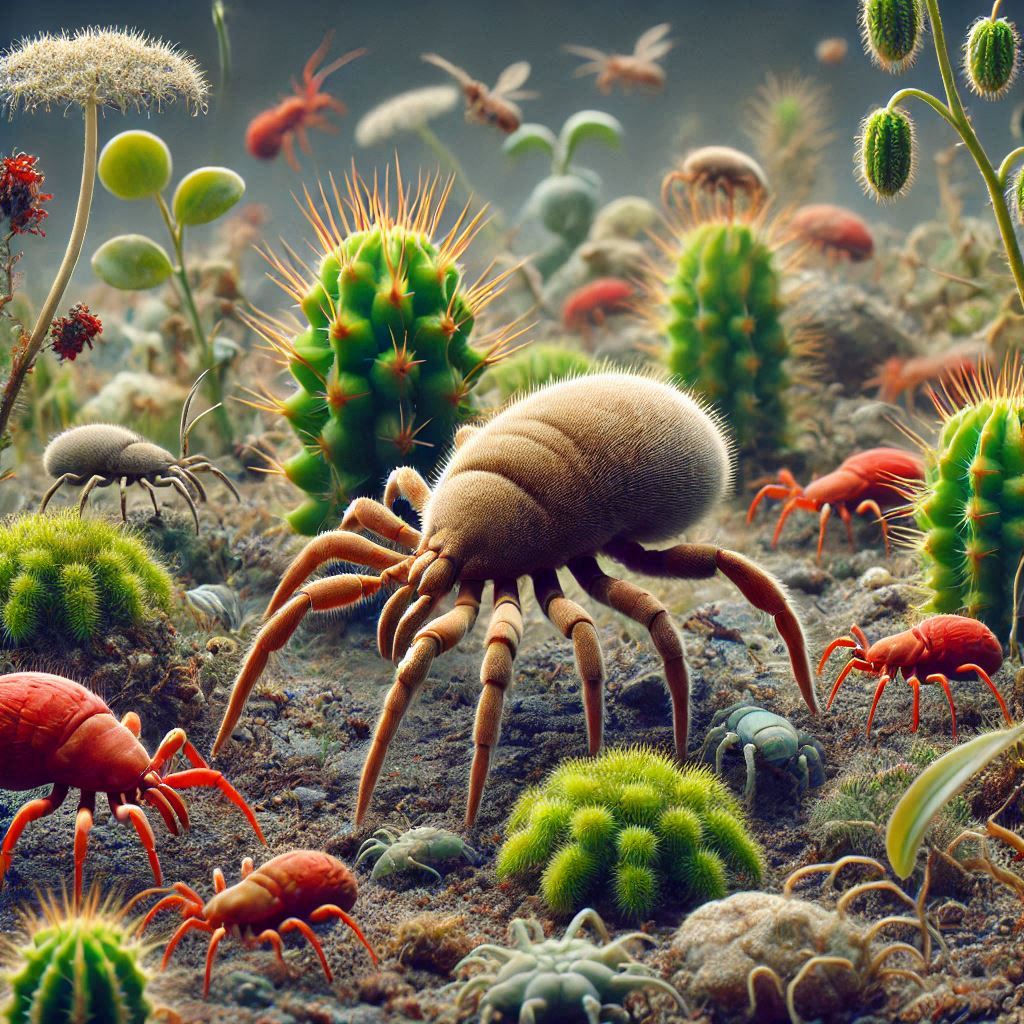Mites, though tiny and often unnoticed, play a surprisingly significant role in our ecosystems. These small arachnids are ubiquitous and found in nearly every habitat on Earth, and their impact on ecological processes is profound. In this essay, we will explore the various ways in which mites affect our ecosystem, highlighting their roles in soil health, plant interactions, decomposition, and as indicators of environmental change.
Introduction to Mites
Mites are arthropods belonging to the subclass Acari within the class Arachnida. They are incredibly diverse, with over 50,000 described species, though estimates suggest there could be hundreds of thousands more yet to be discovered. Mites are found in a wide range of habitats, including soil, water, plants, animals, and even human environments. Their small size, often less than a millimeter long, allows them to occupy ecological niches that are inaccessible to larger organisms.
Soil Health and Fertility
One of the most significant contributions of mites to our ecosystem is their role in soil health and fertility. Soil mites are a diverse group that includes oribatid mites, predatory mites, and fungal-feeding mites, each playing a unique role in the soil ecosystem.
Oribatid Mites
Oribatid mites, also known as beetle mites, are one of the most common groups of soil mites. They are detritivores, feeding on decaying organic matter, fungi, and other microorganisms. By breaking down organic material, oribatid mites help decompose plant and animal residues, contributing to the formation of humus. Humus is a crucial component of soil, as it improves soil structure, water retention, and nutrient availability. The activity of oribatid mites enhances the cycling of nutrients such as nitrogen, phosphorus, and potassium, making them available for plant uptake.
Predatory Mites
Predatory mites in the soil ecosystem feed on other small invertebrates, including nematodes, insect larvae, and other mites. By regulating the populations of these soil organisms, predatory mites help maintain a balanced soil ecosystem. They play a crucial role in controlling soil-dwelling pests that can harm plant roots and reduce crop yields. Predatory mites are often used in agricultural settings as biological control agents to manage pest populations without the need for chemical pesticides.
Plant-Mite Interactions
Mites also have complex interactions with plants, which can have both positive and negative impacts on plant health and productivity. These interactions include herbivory, pollination, and protection from pests.
Herbivorous Mites
Some mites are herbivores, feeding on plant tissues. The most well-known herbivorous mites are spider mites (family Tetranychidae), which can cause significant damage to crops and ornamental plants. Spider mites use their piercing-sucking mouthparts to extract cell contents from leaves, leading to stippling, discoloration, and defoliation. Severe infestations can reduce photosynthesis, stunt plant growth, and lower crop yields. Effective management of spider mite populations is essential for maintaining healthy plants and productive agriculture.
Pollinator Mites
While some mites are harmful to plants, others play a beneficial role as pollinators. Certain mites live in the flowers of plants and contribute to the pollination process by transferring pollen as they move from flower to flower. For example, the family Phytoseiidae includes pollinator mites that are important for the reproduction of some plant species. These mites enhance plant diversity and contribute to the stability of ecosystems by facilitating pollination.
Mutualistic Relationships
Mites can also form mutualistic relationships with plants, where both parties benefit. For instance, some plants produce domatia, small structures on their leaves that provide shelter for mites. In return, the mites protect the plant by feeding on herbivorous insects and pathogens. This symbiotic relationship helps plants reduce damage from pests and diseases, promoting plant health and vigor.
Decomposition and Nutrient Cycling
Mites play a critical role in decomposition and nutrient cycling, processes that are fundamental to ecosystem functioning. By breaking down organic matter, mites contribute to the recycling of nutrients, which supports plant growth and maintains soil fertility.
Decomposer Mites
Decomposer mites, such as oribatid mites and some astigmatid mites, feed on dead plant and animal material. Their feeding activities fragment organic matter, increasing its surface area and making it more accessible to microorganisms such as bacteria and fungi. These microorganisms further decompose the organic matter, releasing nutrients that are essential for plant growth. The combined actions of mites and microorganisms accelerate the decomposition process, ensuring a continuous supply of nutrients in the soil.
Microbial Interactions
Mites interact with microorganisms in various ways that enhance decomposition and nutrient cycling. Some mites carry fungal spores on their bodies, aiding in the dispersal of fungi throughout the soil. This mutualistic relationship benefits both the mites and the fungi, as the fungi gain new habitats and the mites have access to a consistent food source. Additionally, mites create microhabitats through their burrowing and feeding activities, providing favorable conditions for microbial growth and activity.
Indicators of Environmental Change
Mites are sensitive to changes in their environment, making them valuable bioindicators for assessing ecosystem health and monitoring environmental changes.
Bioindicators
Because mites are responsive to environmental changes such as pollution, habitat disturbance, and climate change, they can serve as bioindicators of ecosystem health. Changes in mite communities, such as shifts in species composition and abundance, can provide early warning signs of ecological disturbances. Monitoring mite populations can help researchers and conservationists detect and address environmental issues before they escalate.
Climate Change
Climate change has the potential to impact mite populations and their ecological roles significantly. Changes in temperature, precipitation, and seasonal patterns can alter the distribution and abundance of mites. For example, warmer temperatures may expand the range of certain mite species, potentially leading to increased pest outbreaks. Conversely, changes in environmental conditions may threaten mite species that are adapted to specific habitats, potentially reducing biodiversity and disrupting ecosystem processes.
Conclusion
Mites, despite their small size, have a profound impact on our ecosystems. They contribute to soil health and fertility, interact with plants in complex ways, play a critical role in decomposition and nutrient cycling, and serve as indicators of environmental change. Understanding the ecological roles of mites is essential for appreciating their importance in maintaining ecosystem stability and health. As research in acarology continues to advance, we can expect to uncover even more fascinating insights into the world of mites and their contributions to our planet’s ecosystems.
References
Walter, D. E., & Proctor, H. C. (1999). Mites: Ecology, Evolution, and Behaviour: Life at a Microscale. Springer Science & Business Media.
Krantz, G. W., & Walter, D. E. (Eds.). (2009). A Manual of Acarology. Texas Tech University Press.
Norton, R. A., & Behan-Pelletier, V. M. (2009). Oribatid Mites: A Comprehensive Guide to the Study of Mites in Soil Systems. Elsevier.


Leave a Reply